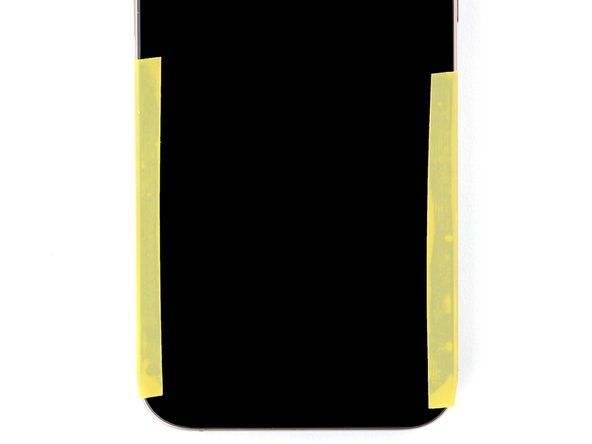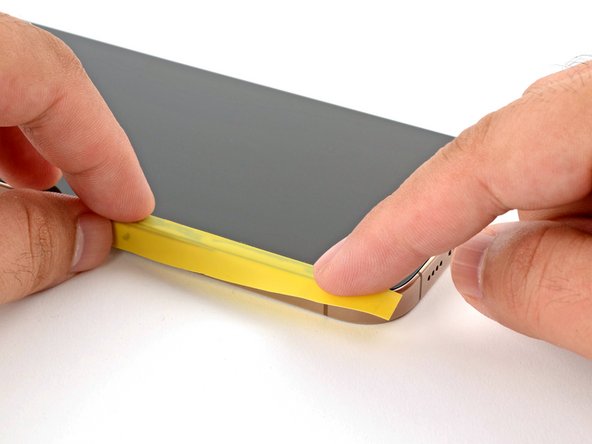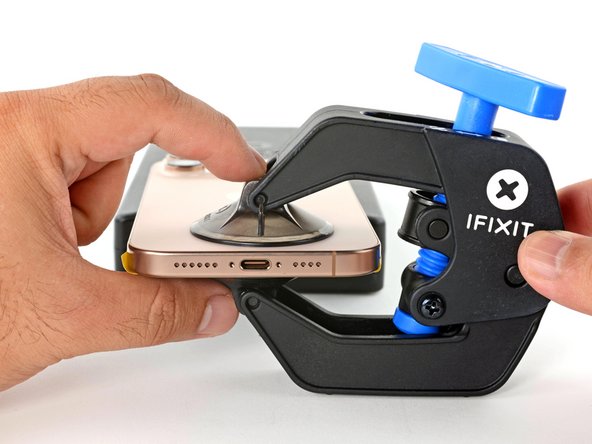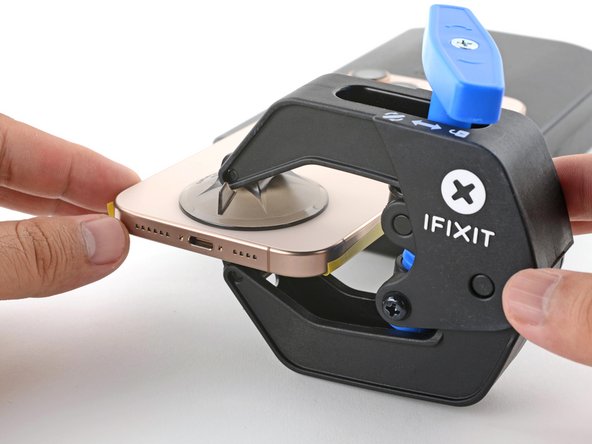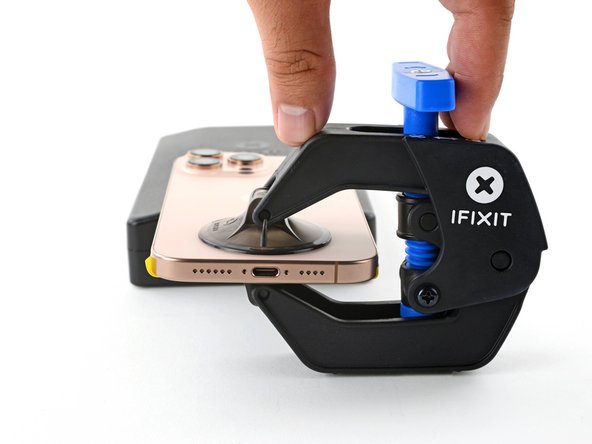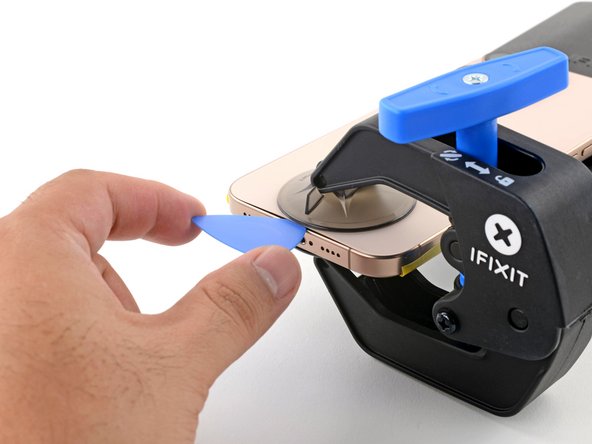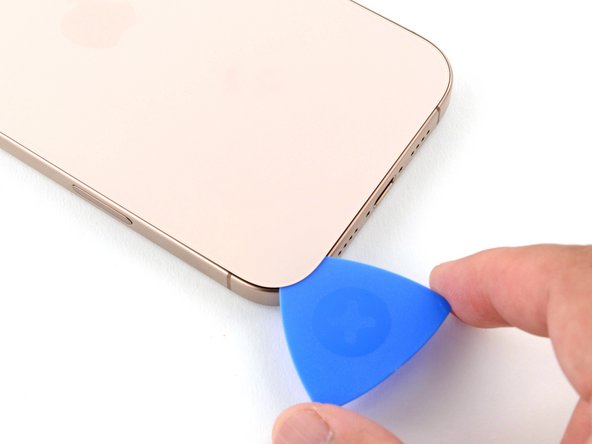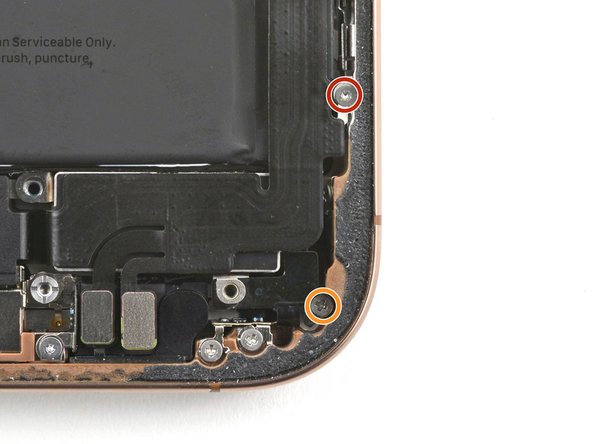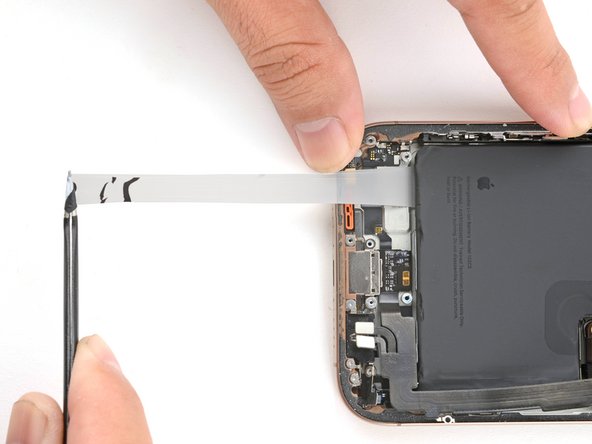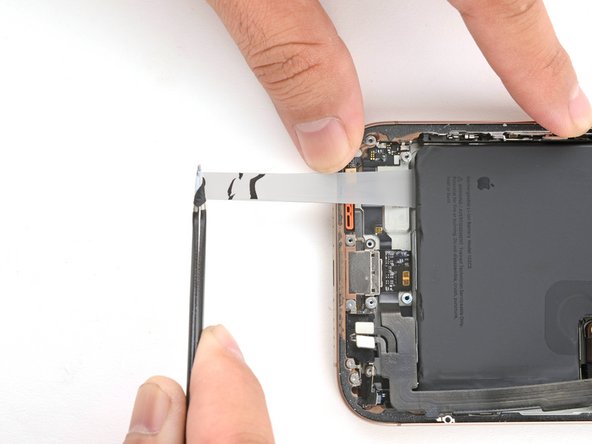How to Replace iPhone 16 Pro Max Battery – Step-by-Step Guide
Duration: 45 minutes
Steps: 46 Steps
Ready to give your iPhone 16 Pro Max a battery makeover? This guide will walk you through the process of removing and replacing that tired old battery. Remember, iPhone batteries are designed to maintain about 80% of their original capacity for around 500 charge cycles, which usually translates to about 18–24 months of use. If your phone seems to be begging for a charge more often or feels a bit sluggish, it might be time for a battery upgrade! And if you notice any swelling, be sure to handle it with care. You’ll need a replacement battery and some back glass adhesive to complete the job. With iOS 18.1, both genuine and aftermarket batteries play nice with your device, so you’re covered there. Once you’re done, don’t forget to run Repair Assistant to reset those battery metrics. If you need help, you can always schedule a repair.
Step 1
Let your iPhone’s battery dip below 25%. A fully charged lithium-ion battery can be a bit of a drama queen when it comes to safety!
– Disconnect any cables from your iPhone.
– Hold down the power button along with either of the volume buttons, then swipe to turn off your iPhone.
Step 2
Find a nice, smooth spot near the bottom edge that’s roomy enough for a suction cup to grab onto. You’ve got this!
– If your screen or back glass is sporting some serious cracks, grab some packing tape and lay down overlapping strips over the glass. This will keep you safe and make it a breeze to take things apart.
Tools Used
Step 3
– Grab your P2 pentalobe driver and carefully remove the two 7.4mm-long screws on either side of the charging port. If you need help, you can always schedule a repair.
Step 4
Be careful not to shove that opening pick in too deep, or you might end up causing some damage to your device. A little tip: mark your pick to keep it safe!
You can also get creative and mark the other corners of the pick with different measurements for extra precision.
Another neat trick is to tape a coin 3 mm from the tip of your pick. It’s a handy guide to keep things safe and sound!
– Measure 3 mm from the tip and give that opening pick a neat little mark with a permanent marker. If you need help, you can always schedule a repair.
Step 5
Get ready for some smooth sailing with the Anti-Clamp! In the next four steps, we’ll show you how this nifty tool makes opening your device a breeze. If you’re not using the Anti-Clamp, no worries! Just skip ahead four steps for a different approach.
The Anti-Clamp works its magic by applying suction to both the screen and the back glass. If you’re just looking to pop open the back glass, remember to tape down the screen first. Need a refresher on how to use that tape? We’ve got you covered!
For the complete scoop on using the Anti-Clamp, take a look at this guide.
Just a quick reminder: make sure the tape is only holding the screen in place, not the back glass.
– Grab two strips of tape and lay them along the long edges of your iPhone. Now, give those strips a little fold over the screen to keep everything nice and snug!
Step 6
If your iPhone’s surface feels like a slippery slide for the Anti-Clamp, just slap on some tape to give it a little grip and make things easier.
– Pull back the Anti-Clamp’s blue handle to free the arms.
– With the back glass facing up, slide the arms over the right edge of your iPhone. One suction cup goes on the back glass and the other on the screen. Center them near the bottom edge.
– Support your iPhone so it stays level while snug between the Anti-Clamp’s arms—a small box works great.
– Squeeze the cups together to create suction.
Step 7
If tape isn’t on hand, try warming up those suction cups a bit—they’ll stick better and make your task easier!
– Give that blue handle a gentle tug forward to lock those arms in place.
– Now, twist the handle a full 360 degrees or until you see those cups starting to stretch out.
– As those cups stretch, keep an eye on their vertical alignment. If they start to slip, no worries! Just take off the Anti-Clamp and use some tape to help those cups stick.
Step 8
Watch out for the heat! Keep your iPhone cool and cozy—too much warmth can spell trouble for the battery.
If you don’t see a gap after a minute, don’t sweat it! Just give it a bit more heat and twist that handle a quarter turn. Let the Anti‑Clamp and some time work their magic for you.
– Grab a hair dryer or heat gun and warm up the bottom edge of the back glass until it’s hot to the touch.
– Wait for up to a minute for the adhesive to loosen and a gap to appear between the back glass and the frame.
– Slip an opening pick into the gap.
– Remove the Anti-Clamp by using the pull tabs on the suction cups.
– Skip the next two steps.
Tools Used
Step 9
The next two steps show how to get things started using a suction handle.
You can also use an iOpener to heat the back glass. Follow these steps to heat and apply the iOpener properly. If you need help, you can always schedule a repair.
– Grab your trusty hair dryer or heat gun and gently warm up the bottom edge of that back glass until it feels nice and toasty!
Tools Used
Step 10
If you don’t see a gap forming, just crank up the heat a bit more along the edge and give it another go!
– Pop a suction handle on the bottom edge of the back glass.
– Give the handle a good, steady pull to create a gap between the back glass and the frame.
– Slide the tip of an opening pick into the gap.
Tools Used
Step 11
As you carefully cut through the adhesive holding the back glass in place, remember to keep your pick no deeper than 3 mm to steer clear of any sensitive areas below. Happy repairing!
– Be careful not to poke around here! There’s a fragile cable snuggled right next to the volume up button that connects the back glass to your iPhone. Avoid using your pick in this area to keep that cable safe and sound.
– You’ll find several spring contacts scattered around the edge of the iPhone. Just a friendly reminder to watch your step!
Step 12
If the adhesive’s playing hard to get, give it a quick reheat for a minute and try again.
– Gently glide the opening pick along the bottom edge to cut through the adhesive like a pro.
– Keep the opening pick snug in the bottom-left corner to ensure that pesky adhesive doesn’t try to stick back together.
Step 13
– Grab your trusty hair dryer or heat gun and warm up the left edge of that back glass until it feels nice and toasty!
Tools Used
Step 14
Keep your pick to a maximum depth of 3 mm to steer clear of any damage to those delicate spring contacts!
As you glide through, you’ll hear and feel those metal clips giving way—it’s a satisfying moment!
– Pop a second opening pick into the bottom-left corner, right next to your first pick. You’re doing great!
– Gently glide your pick along the left edge to break the adhesive seal and set those metal clips free.
– Keep that pick snugly in the top-left corner to stop the adhesive from getting cozy again.
Step 15
– Grab your trusty hair dryer or heat gun and warm up the top edge and top-right corner of the back glass until it feels toasty.
Tools Used
Step 16
Don’t dig in too deep! Keep your pick to about 3 mm to avoid messing up those spring contacts.
– Pop in a third opening pick at the top-left corner to get things started.
– Gently glide that pick along the top edge and around to the top-right corner, pausing just above the volume up button.
– Keep this pick in place to ensure the adhesive doesn’t decide to play tricks on you!
Step 17
– Grab your trusty hair dryer or heat gun and warm up the right edge of that back glass until it feels just right to the touch!
Tools Used
Step 18
Keep it cool and don’t push your pick deeper than 3 mm, so the spring contacts stay safe!
– Pop a fourth opening pick into the bottom-right corner.
– Slide the pick around the corner and up along the right edge until just below the volume down button.
– Leave this pick in place to keep the adhesive from sticking back together.
Step 19
Alright, time to check in on that back glass! It should be popping free from the frame now. If it’s still feeling a bit clingy, just take a stroll around the edges with your pick to see if there are any sneaky bits of adhesive or stubborn clips holding it back.
– Pop the back glass open to the right of your iPhone to loosen the rest of the adhesive.
– Prop up the back glass with a clean and sturdy object.
Step 20
– Grab your trusty tri-point Y000 driver and let’s tackle those three screws holding the battery connector cover in place:
– Two screws that are 1.3 mm long
– One screw that’s 1.0 mm long
Step 21
– Gently lift off the cover that protects the battery connector and set it aside.
Step 22
– Grab your trusty spudger and gently pry up to disconnect that battery press connector. You’ve got this!
– When it’s time to reattach those press connectors, just line them up like a pro and press down on one side until you hear that satisfying click. Then, do the same on the other side. Easy peasy!
Tools Used
Step 23
– Grab your trusty tri-point Y000 driver and let’s get to work! First, we need to unscrew the four little screws holding down the back glass connector cover:
– Two screws measuring 1.3 mm in length
– Two screws that are 1.0 mm long
Step 24
– Gently pop the back glass connector cover straight up and set it aside. You’ve got this!
Step 25
– Grab your trusty spudger and gently pop off that back glass connector! If you need help, you can always schedule a repair.
Tools Used
Step 26
Now’s a great time to give your repair a test drive before closing up your iPhone. Reconnect the battery and back glass temporarily, power it on, and make sure everything’s working smoothly. Then, power it back down and continue reassembly. If you need help, you can always schedule a repair.
– Pop off the back glass.
– When putting it back together:
– Follow this guide to reapply adhesive and secure your back glass. If you need help, you can always schedule a repair.
Step 27
– Grab that trusty Phillips screwdriver and let’s tackle those screws holding down the Taptic Engine cover:
– One 2.9 mm-long screw
– One 1.3 mm-long screw
– One 2.4 mm-long screw
Step 28
– Grab your trusty tweezers or just your fingers and gently lift the top edge of the Taptic Engine cover.
– Once you hear that satisfying little pop from the bottom edge as it unhooks from the frame, go ahead and take off the Taptic Engine cover.
– When you’re putting it all back together, just make sure that bottom edge clicks back into place with the frame. You’ve got this!
Tools Used
Step 29
– Grab your trusty spudger and gently pry up that lower assembly cable from the logic board. You got this! If you need help, you can always schedule a repair.
Tools Used
Step 30
– Grab your trusty spudger and gently work the point under those two connectors hanging out by the bottom right corner of the frame. Give them a little nudge to disconnect them, and you’re on your way!
Tools Used
Step 31
– Let’s start by removing the two screws holding down the lower assembly cable:
– One 1.0 mm‑long tri-point Y000 screw
– One 1.3 mm‑long Phillips screw
Step 32
– Grab your trusty hair dryer and give the lower assembly cable section above the Taptic Engine a warm-up until it’s nice and toasty to the touch!
Tools Used
Step 33
– Gently slide an opening pick beneath the lower assembly cable to give it a nudge away from the Taptic Engine.
– Carefully bend the cable aside to clear the path to the Taptic Engine. You’ve got this!
Step 34
– Grab a Phillips screwdriver and gently twist out the 2.1 mm-long screw that’s holding the Taptic Engine snugly in place. You’ve got this!
Step 35
– Grab your trusty spudger and gently nudge that corner bracket upwards like you’re encouraging it to join the party!
Tools Used
Step 36
– Gently glide the tip of your opening pick along the top edge of the Taptic Engine to carefully detach the plastic buffer strip that’s sticking to it. Remember, you’re doing great!
Step 37
Take it easy and steer clear of prying against the battery.
– Grab your trusty spudger and gently nudge the Taptic Engine up. It’s like giving it a little lift!
– Now, go ahead and take out the Taptic Engine. You’ve got this!
Tools Used
Step 38
– Let’s get started by taking out the four screws that are holding the loudspeaker in place:
– One 1.7 mm-long Phillips screw
– One 1.5 mm-long Phillips screw
– One 4.1 mm-long standoff screw
– One 1.3 mm-long tri-point Y000 screw
Step 39
– Slide the tip of a spudger under the loudspeaker’s bottom-right screw hole.
– Gently pry it up and lift out the loudspeaker.
Tools Used
Step 40
Stay cool and handle the battery with care. Keep sharp tools far away to avoid any accidental damage.
Your iPhone’s battery is held in place by three stretch release adhesive strips. In the next four steps, we’ll guide you through removing them so you can give your battery the freedom it deserves!
Step 41
Hold your horses! Don’t yank that tab out from under the battery just yet.
– Grab the tip of an opening pick and gently pry up that black pull tab at the bottom of the battery. It’s like giving it a little nudge!
– If it’s being a bit stubborn, don’t hesitate to use tweezers to help peel that tab away from the battery. Teamwork makes the dream work!
Tools Used
Step 42
If a strip decides to take a vacation and breaks off, gently fish it out from beneath the battery. If it’s playing hard to get, no worries—just move on to the next strip.
Give that strip some time to stretch its legs and re-grip it as needed. Just remember, it doesn’t like to be dragged over the delicate components or cables hiding above the battery.
When the strip gets a bit too lengthy, wrap it around your tweezers like a pro and keep on pulling!
– Grab that pull tab with your trusty tweezers or your fingers — whichever feels right!
– Gently pull the adhesive away from the battery, keeping it as low to the surface as possible. Slow and steady wins the race!
Tools Used
Step 43
Gently nudge the lower assembly cable aside to reveal those sneaky adhesive strips waiting to be tackled.
– Go ahead and tackle the next two adhesive strips just like you did before! You’ve got this!
Step 44
If any adhesive strips tore, don’t worry. Jump to the next step to use isopropyl alcohol for removal.
If your new battery isn’t sticky yet, follow this guide to put on new stretch-release adhesive strips, or go with thin, double-sided tape to keep it in place.
– If you’ve successfully peeled off all three stretch release adhesive strips, way to go! Now, gently lift and remove the battery.
– Ready to pop in a new battery? Here’s how:
– First, give your frame a quick cleaning with some isopropyl alcohol and a lint-free or microfiber cloth. We want it looking sharp!
– Before sticking anything down, give your new battery a test run: reconnect it temporarily and make sure it fits snugly in its little home and that the cable reaches the logic board socket. Don’t forget to disconnect the battery once you’ve checked!
Step 45
Next up, let’s tackle removing the battery if those sticky strips gave out.
– Gently lift the bottom edge of the frame to give your iPhone a little tilt.
– Grab a pipette or syringe and drop 2–3 drops of high-concentration (>90%) isopropyl alcohol along the bottom edge of the battery, right near those pesky broken adhesive strips.
– Now, let’s play the waiting game! Give it about a minute for that isopropyl alcohol to work its magic and loosen up the adhesive under the battery.
Step 46
Handle that battery with care! No bending or creasing, please. If it’s putting up a bit of a fight, just add a few more drops of isopropyl alcohol and give it another go.
If your new battery doesn’t come with adhesive pre-installed, follow this guide to apply fresh stretch release adhesive strips, or use thin, double-sided tape to secure it. If you need help, you can always schedule a repair.
– Wedge the flat side of your opening pick between the left side of the battery and the frame.
– Gently pry the battery up, applying steady pressure. Give the adhesive time to let go.
– Once the adhesive loosens its grip, grab and remove the battery.
– To install a new battery:
– Wipe down the frame with isopropyl alcohol and a lint-free or microfiber cloth.
– Before applying new adhesive, temporarily connect your new battery and place it in its slot to make sure it fits and the cable reaches the logic board socket. Disconnect the battery before proceeding.
– If you need help, you can always schedule a repair












